This article will examine the various types of buttons and the materials they are made of to give you an idea of what you should choose for a shirt, jacket, or winter coat.
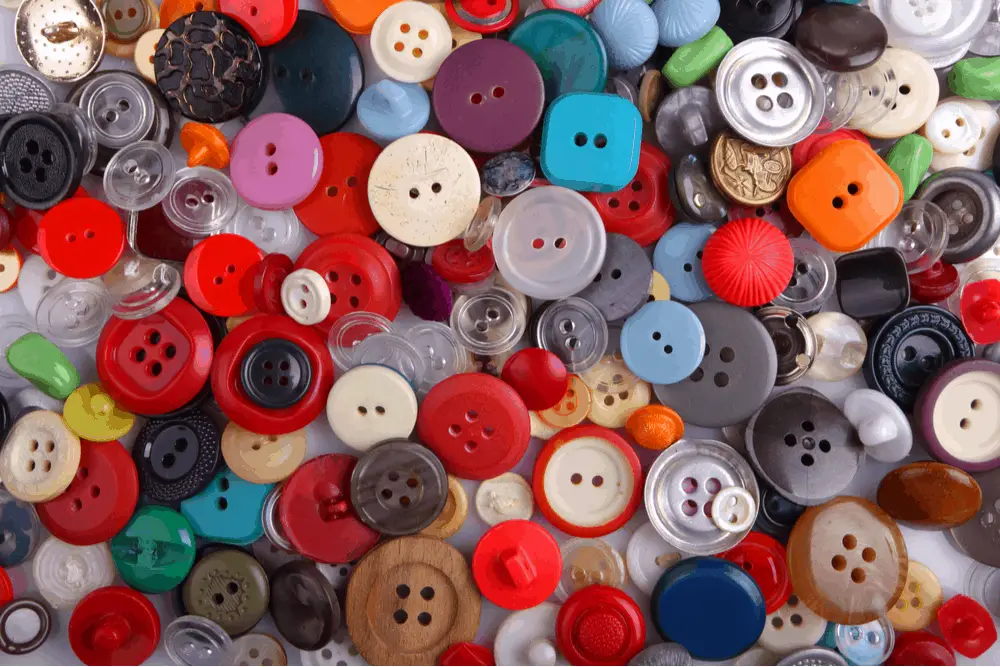
When you put on a shirt in the morning do you even look at the buttons? Probably not, especially if they’re simple plastic ones. It’s just buttons, right?
To you and me, yes, but it took mankind thousands of years to come up with the standard four-hole buttons, which started to be mass-produced only in the 19th century, after the Industrial Revolution.
Today, buttons are available in a multitude of shapes and materials and they have the power to make or break an outfit.
Table of Contents
What Are the Different Types of Buttons?
Here is a list of the different types of buttons, the materials that are made of, and how to choose them for your clothing and accessories.
Chinese/Frog Buttons

Frog buttons are used mainly for their decorative purpose as they’re meant to stand out and provide a finishing touch to a shirt or coat. Originally from China, this type of fastening has long been used to decorate military uniforms in the Western world.
Frog buttons are made of braided pieces of fabric or rope, but you might also find metal Chinese buttons. Traditionally the two pieces of such a button were sewn far apart on the right and left side of a coat and held together with an elegant loop.
However, most modern frog buttons are sewn next to each other and held in place with a hook and eye fastening.
Covered Buttons
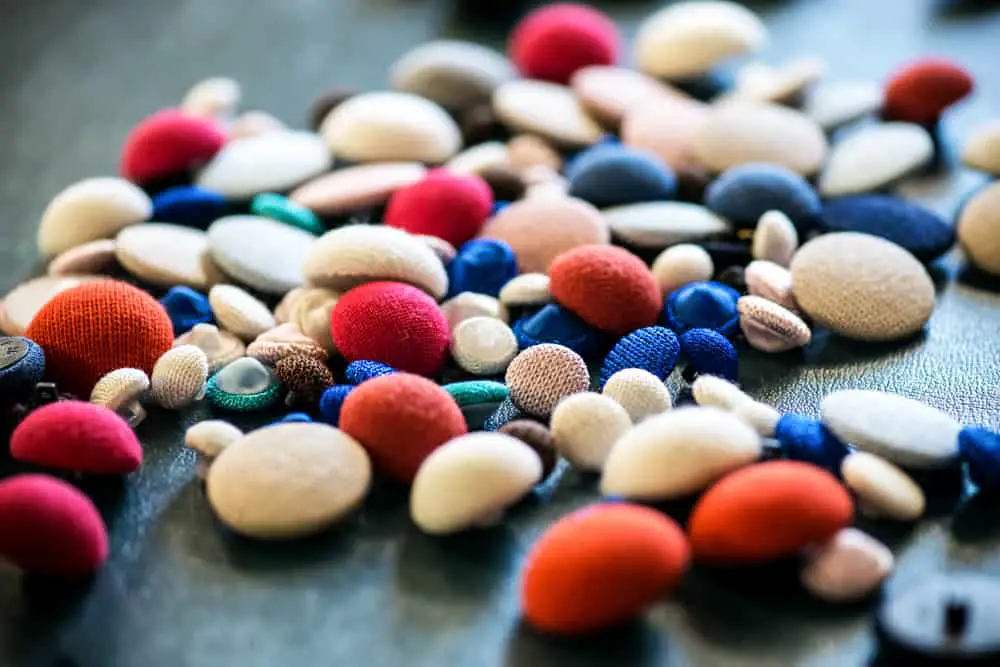
Covered buttons give any outfit a very polished look. On the inside, it’s just a nondescript shank button, made of metal or cheap plastic. What matters is that someone took the time to dress up that button in a nice piece of fabric matching that of the garment.
Such buttons can be covered with the exact fabric as the garment, so they become practically invisible, or they can be covered with a colored material to stand out on a unicolor jacket. Such buttons are used for thick coats or to give a nice touch to a formal two-piece business suit.
Customized Buttons
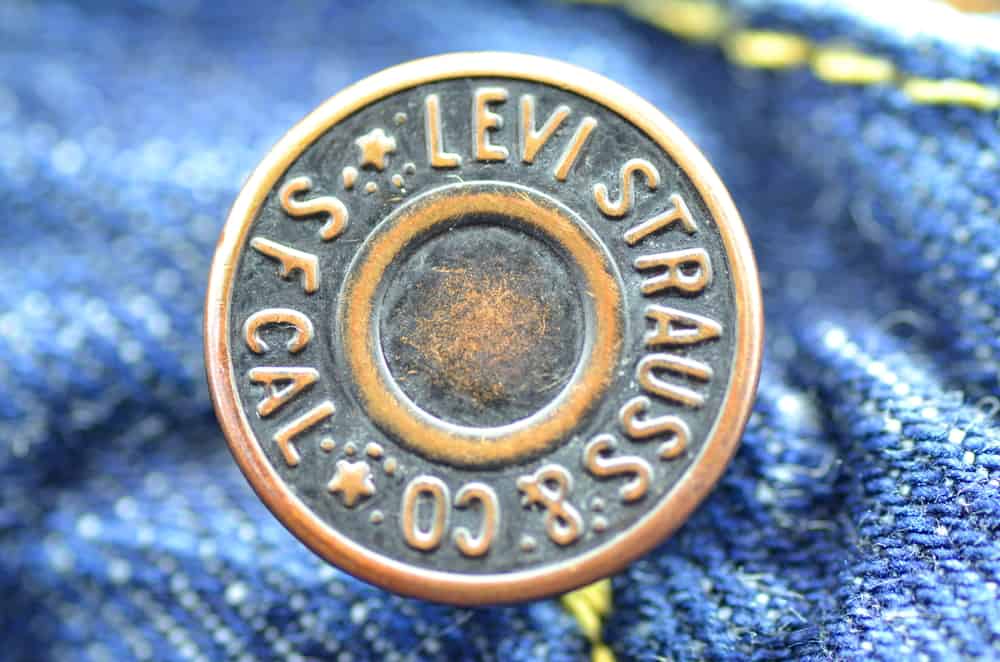
Big brands and fashion designers prefer to use customized buttons since these can be ordered in small batches and stand out for their particular design. Customized buttons can be made of any material, even cheap plastic, as long as they carry the name or the logo of the brand.
Designers looking for a unique look will also use made-to-order buttons covered in painted silk or elegant velvet. They are more expensive than the basic plastic buttons, but so are the types of clothing they go on. If you want a classy look, you have to be prepared to pay a bit more.
Decorative Buttons
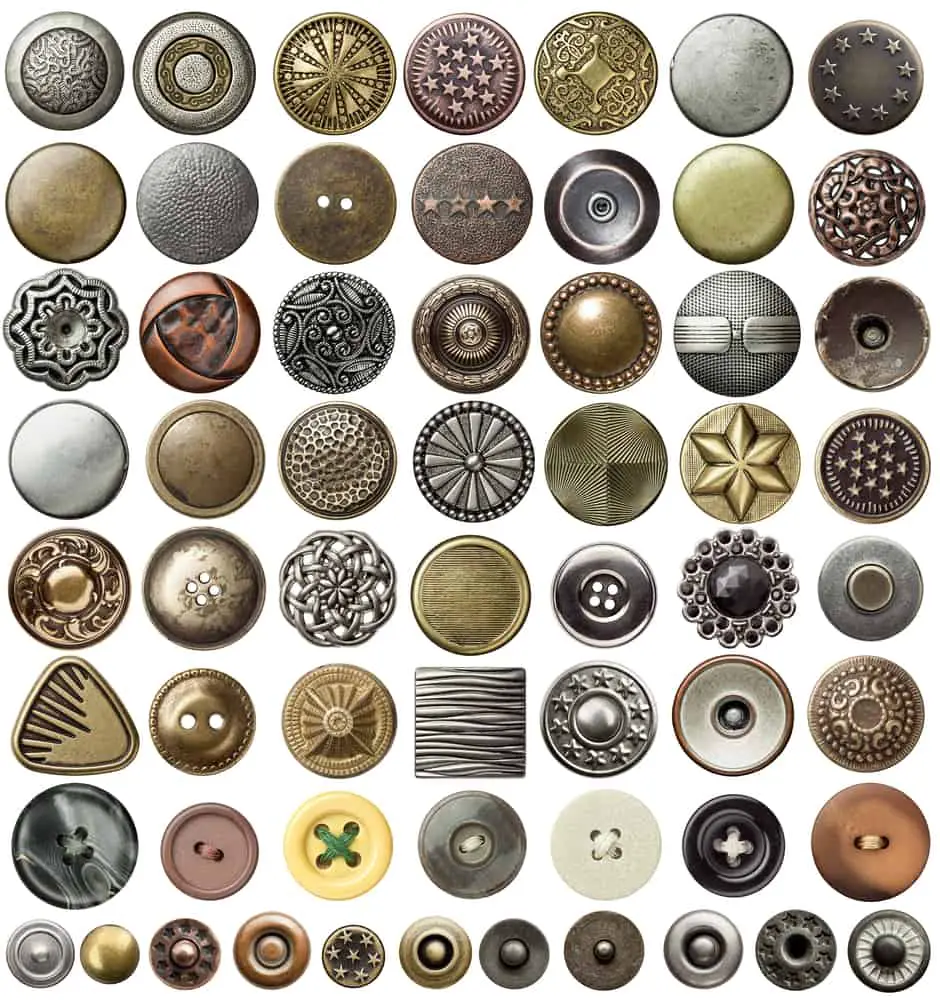
These count as royalty among buttons, as they come in various shapes and colors. They still serve their original purpose of fastening a shirt or coat, but they’re there to add a bit of class. Decorative buttons can be made of plastic, ceramic, glass, enamel, or mother of pearl.
They’re mostly used for women’s clothing and come in enchanting shapes, flowers, butterflies, dolphins, or small hearts. Such buttons are meant to be seen and admired, only make sure they’re sewn well as it’s highly unlikely you’ll find a replacement.
Flat Buttons
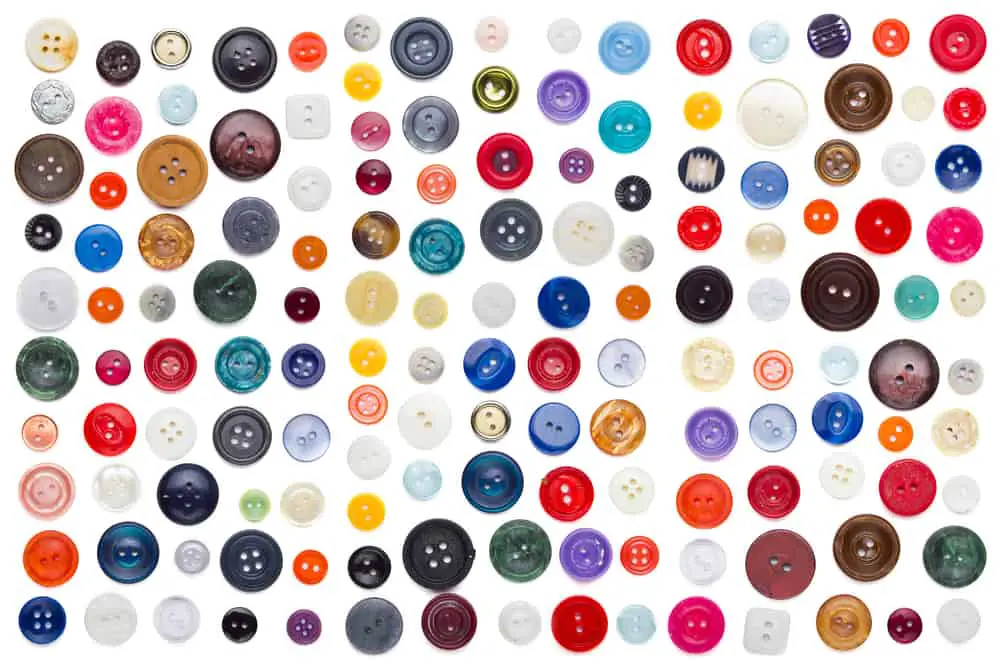
Flat buttons belong to the modern era of mass-produced clothing. They are flat on purpose, so they can be sewn using a sewing machine. Most flat buttons come in plastic, with two or four holes for sewing them onto the fabric.
You can also find flat buttons made of metal, wood or mother of pearl. The flat buttons you’ll see on most shirts are either white or transparent, but they can be produced in every imaginable color.
If you buy something with very common white plastic flat buttons, losing one won’t be much of a problem since you can easily replace them. On the other hand, some manufacturers have come up with ridged edges to give this humble button a fancier look.
Four-Hole Buttons

If you need a reliable button this is it. The four-hole pattern allows for more secure sewing, so you won’t lose the button that easily. Four-hole buttons are usually flat, and they can be made out of plastic, wood, or metal.
In most cases, the thread matches the color of the button, but if you want to get creative you can sew them with a thread in a different color for a pleasant visual effect. Even a very plain shirt will get a funky look if you use colored buttons and thread in a contrasting color.
Hook and Eye Buttons
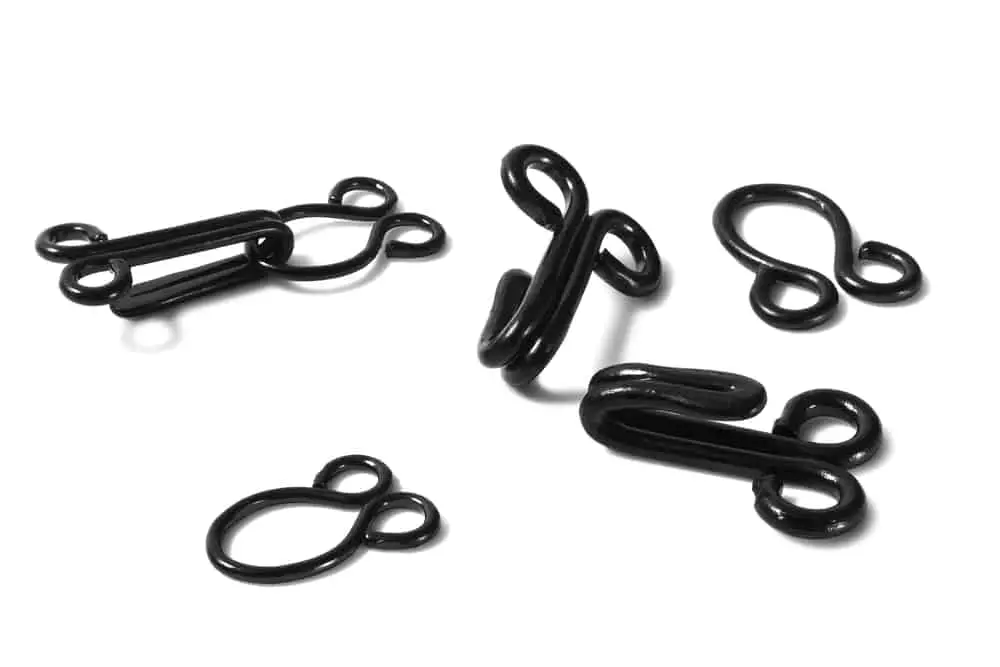
The hook and eye fastening count as a button, a very discreet one, usually hidden from sight. Such a fastening consists of a small hook made of metal that goes through a sort of loop, aka the eye. This type of button is very common on bras, but also on skirts, jeans, and even coats.
Yes, you need to sew both pieces and make sure they align properly, but, on the other hand, it’s a very secure type of fastening. The greatest advantage is that this fastening is almost invisible.
When you wear a very tight skirt, you don’t want a button sticking out on the waistband, so the hook and eye are the perfect choices.
Lapel Buttons
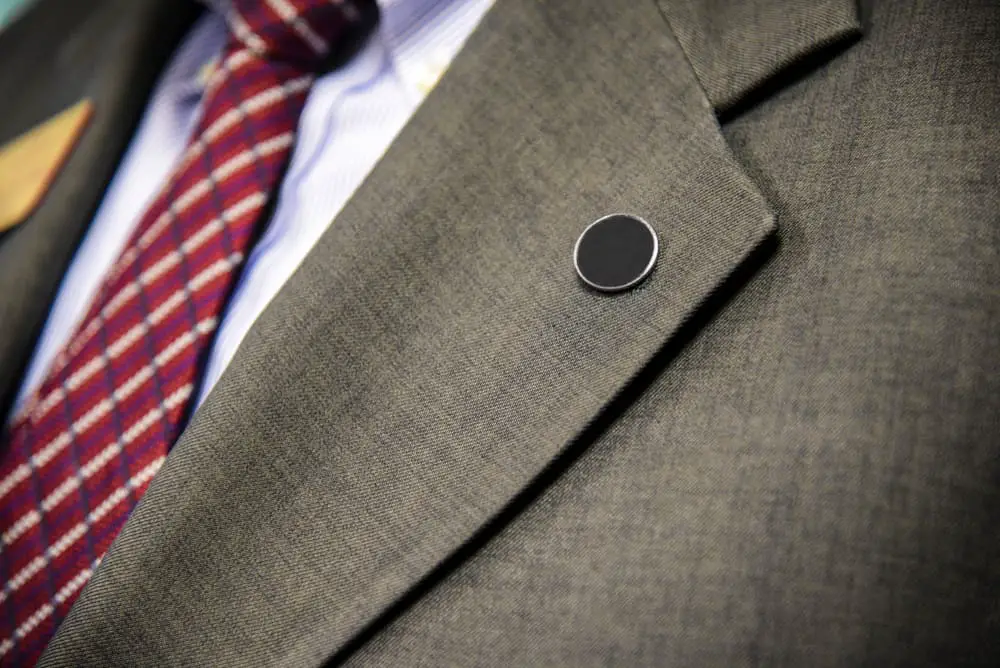
Lapel buttons were first invented in 13th century China using a sophisticated inlaying technique. In the Western world, George Washington was the first politician to wear such buttons with a message at his 1789 inauguration.
His buttons still served their original purpose of fastening his coat, but nowadays lapel buttons only have a decorative role. They’re not even buttons anymore, but pins people wear to mark their support for a political party or to show their affiliation with an organization or movement.
They are not sewn to a lapel but fastened with a pin, so you can easily put them on whatever you want to wear.
Magnetic Coat Buttons

Magnetic sew-on buttons are becoming increasingly popular since it’s very easy to fasten or unfasten a coat quickly using just one hand. Such buttons are used for hidden fastenings, which makes them great for thick coats, as well as bags or pockets.
Magnetic buttons are typically round and have two or more holes on the edges so you can sew them on the fabric. While some do come in black color, that of basic magnets, most are dyed in fancy bright colors for a stylish look.
Shank Buttons / One-Hole Buttons
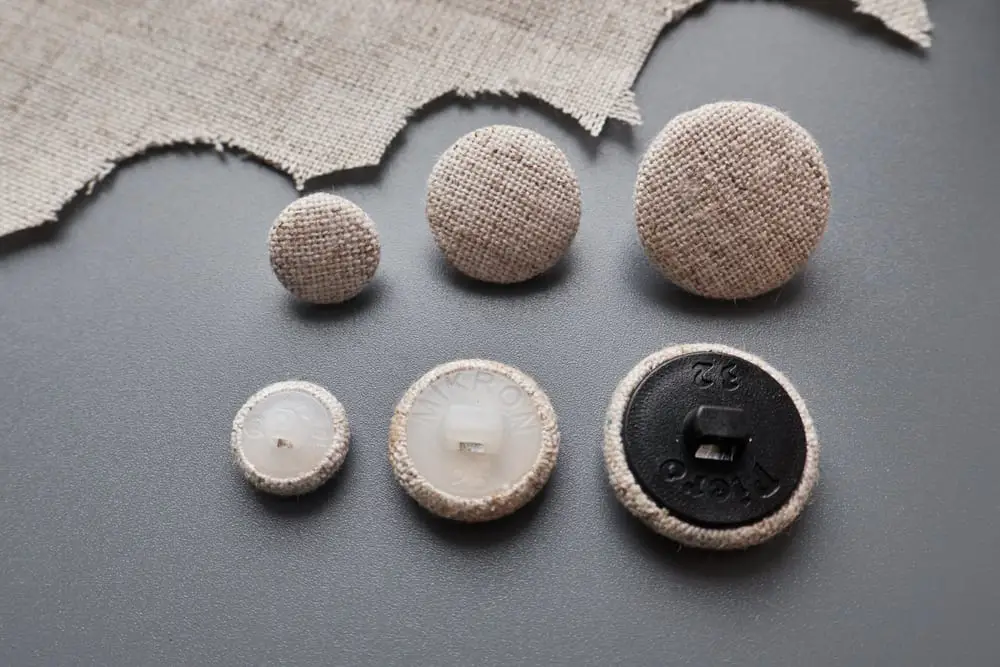
Shank buttons are more decorative than your basic flat button since they have a slightly domed shape and stand out better on a piece of fabric. They’re typically referred to as one-hole buttons since the needle and thread go through one loop at the back of the button.
That can be an advantage if you’re not very good at sewing as no one will see what’s under the button. Shank buttons can be made of plastic, but most often you’ll find them in metal, wood, or covered in a fabric matching that of the garment.
Since they’re bigger and heavier than the flat type, shank buttons should be used on thicker fabrics, jackets, and coats rather than on a delicate silk blouse.
Shirt Buttons
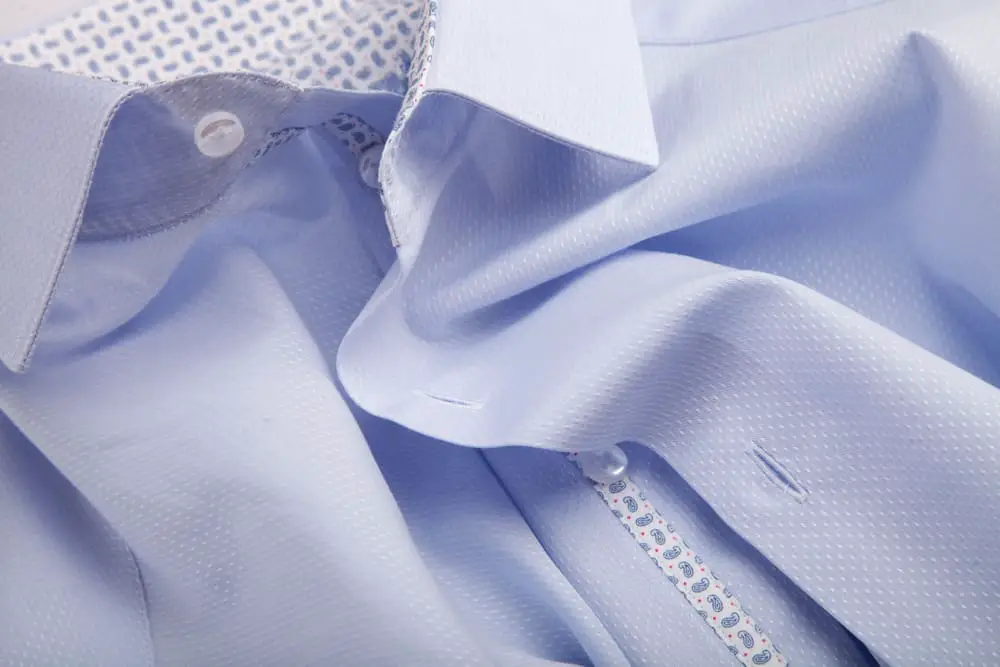
Most men’s shirts use a very basic type of flat button with two or four holes. However, on more expensive items, and for women’s shirts, the buttons can be made from mother of pearl. At the same time, a denim shirt might have metal flat buttons.
Shirt buttons are not made to stand out, they’re there to serve a purpose, so they’ll mostly be in a muted color matching the pattern of the fabric.
If you look closely at a shirt you’ll notice that although they look pretty much the same, the buttons on the collar or cuffs are usually smaller than those on the front.
Snap Buttons

Snaps are a more modern type of buttons and they’re mostly used for leather, jeans, or wind jackets. Snap buttons consist of two pieces that are pressed together and close with a pop. This type of fastening is made of either plastic or metal, which is more resistant.
Snap buttons are a great solution when you need a strong and practically hidden sort of fastening. The only visible part, the cap, can come in various colors or etched with a pattern or logo.
Such buttons are typically put in place during the fabrication process and if one gets broken it might be a bother to have it replaced since they are not like ordinary buttons that you can sew back on.
Stud Buttons / Jeans Buttons

Most jeans and jeans jackets use studs as buttons because they are very resistant. A stud is made of two metal parts fitted together with a special machine and it’s probably still gonna be in place when the jeans themselves are worn out and so faded you only wear them to mow the lawn.
The outside part of the stud is usually branded with the company logo so you can wear your jeans with pride, but also as a mark, the garment is original.
Toggle Buttons
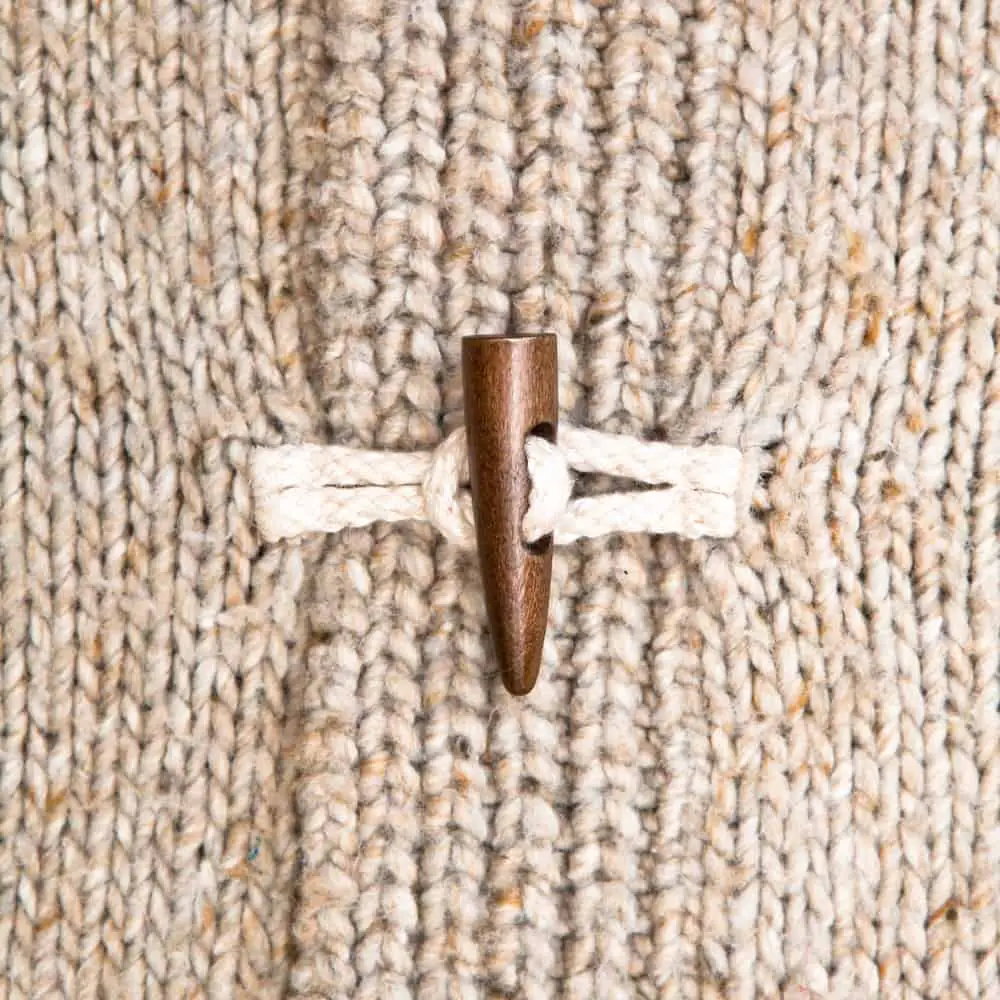
Toggle buttons stand out for their original elongated shape. They are basically a piece of carved wood with two holes in the middle to sew them in place. To fasten a garment, toggle buttons go through a loop which can be made of fabric, rope, or leather.
Since there are so many types of wood out there, toggle buttons differ in texture and shade, although they can also be painted in a color to match the outfit.
Toggle buttons are big and heavier than plastic ones, which is why you’ll see them mostly on thick autumn and winter coats. They go particularly well with knitted wool vests.
Two-Hole Buttons

If you want a user-friendly button, that’s the two-hole button. If you ever need to sew back on such a button you won’t have any trouble figuring out how to do it. The two-hole pattern is widely used for inexpensive plastic buttons you’ll find on everyday shirts.
Hint: When you buy such an item, do check out if the buttons are sewn firmly, as sometimes they tend to hang a bit loose and you don’t want to spend a whole day at the office with a missing button.
On the other hand, you can also find two-hole buttons made of metal or shiny mother of pearl. Again, look out, as you definitely won’t want to lose a button with an original design.
What Are the Different Types of Button Materials?
Bone Buttons
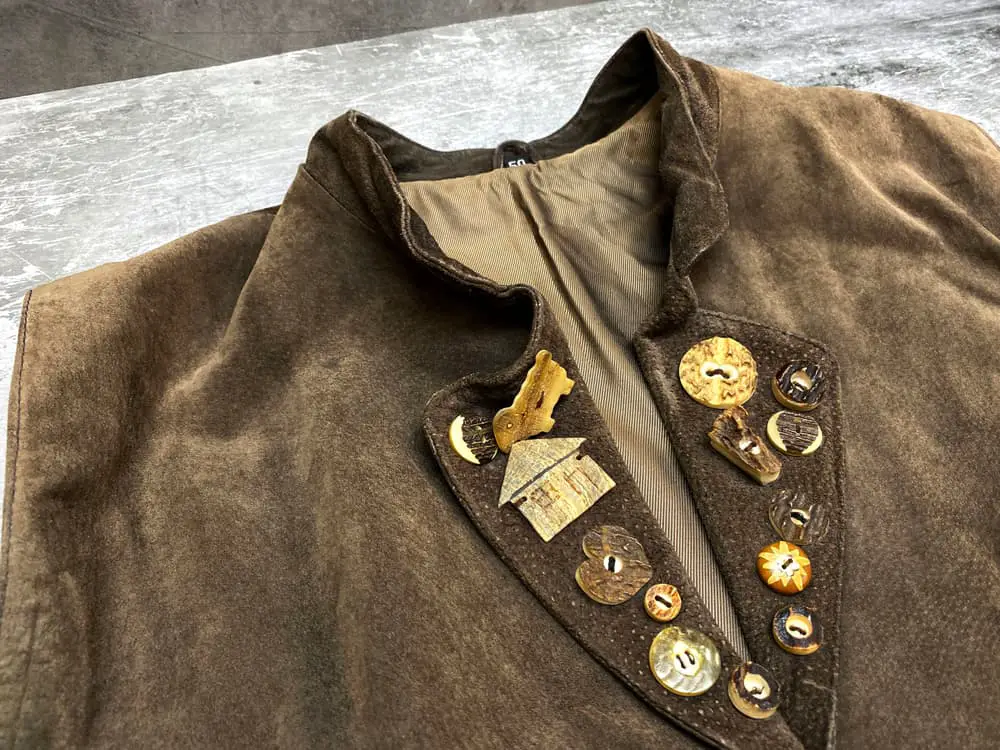
Some say bone buttons are the oldest type of buttons and it might very well be so. If there’s one thing the primitive men had in abundance, that’s probably bones from the animals they managed to kill.
Bone buttons are usually made from buffalo and cow leg bones. They’re very resistant and they give a more natural feel to a garment.
Most bone buttons are usually flat, but you can also find toggles made of bone and these give a very elegant look to a coat. For a more refined look, some bone buttons have ridges or etchings on the margins.
Cloth Buttons
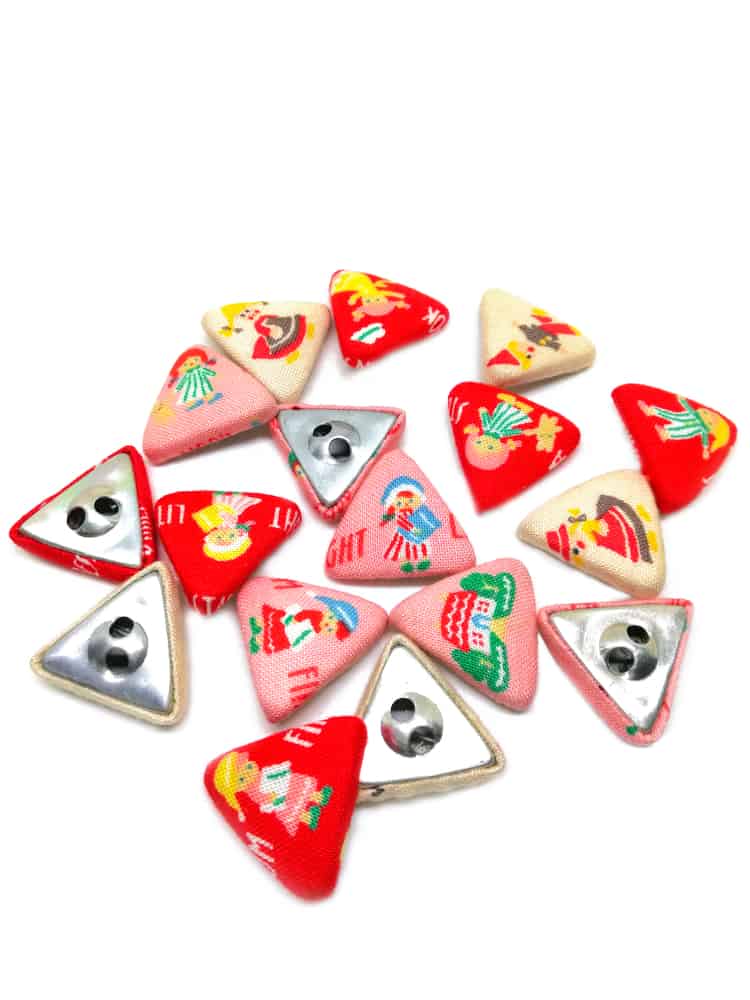
Eye-catching and quite easy to make! Many cloth buttons are handmade, to give a garment a unique look. For a raised, more visible button you can use a shank button covered with a piece of cloth, but you can also use small wood discs or even coins to make cloth buttons.
The fabric is sewn in place on the underside of the button and is affixed to the fabric of the garment. It’s a cheap and highly-effective way to style up a shirt.
The cloth covering the button can be in a single color, preferably a bright one, or it can be from the same fabric the garment is made of.
Corozo / Tagua Buttons
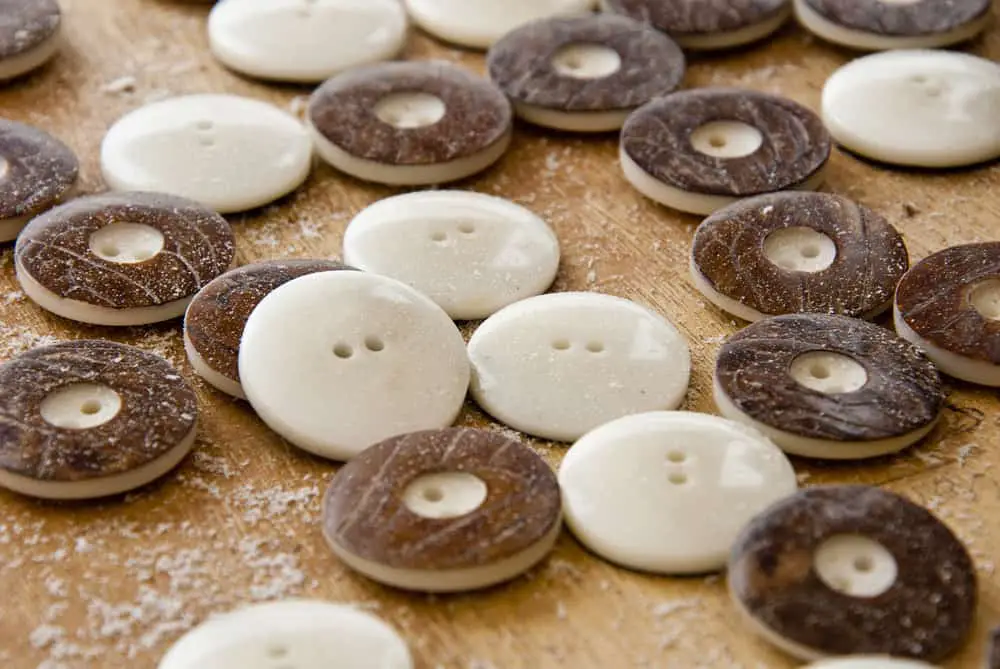
Corozo buttons are very trendy and eco-friendly. They are made from corozo nuts, also known as tagua nuts, which grow in the northern parts of South America.
And, no, they’re not made from the shell of the nut, but from the fruit. Corozo nuts are made of a cluster of seeds filled with an ivory liquid which hardens over time.
This substance will get hard enough to withstand cutting, carving, and polishing and the buttons made of it look spectacular, all smooth and shiny. The material is scratch-resistant and the colors won’t fade with time.
Crystal or Rhinestone Buttons

This type of button is highly-praised for its ornamental properties. A rhinestone button is much more than a fastening, it’s a fashion accessory that doubles as jewelry. Crystal and colored rhinestone buttons are usually shank buttons that are sewn to the fabric through a loop underneath.
The rhinestones will be selected so they match the color of the shirt or dress. Some are made from inexpensive colored glass, but some are made of beautiful Swarowski crystals.
This type of button goes well on silk and other light fabric garments. When wearing such buttons, choose your jewelry carefully to avoid clashing styles.
Enamel / Resin Buttons

Enamel and resin buttons might look quite similar but they’re very different materials. Enamel, or rather vitreous enamel, is glass fused to a metal surface at very high temperatures, while the resin is a sort of plastic applied in one or two layers and is often referred to as cold plastic enamel.
For the untrained eye, they appear pretty much the same, but the genuine enamel is scratch-resistant and tougher than the plastic one.
Either way, they’re very fashionable as the colors can be applied in a variety of patterns and have a handmade look even when they are not.
Fabric Buttons
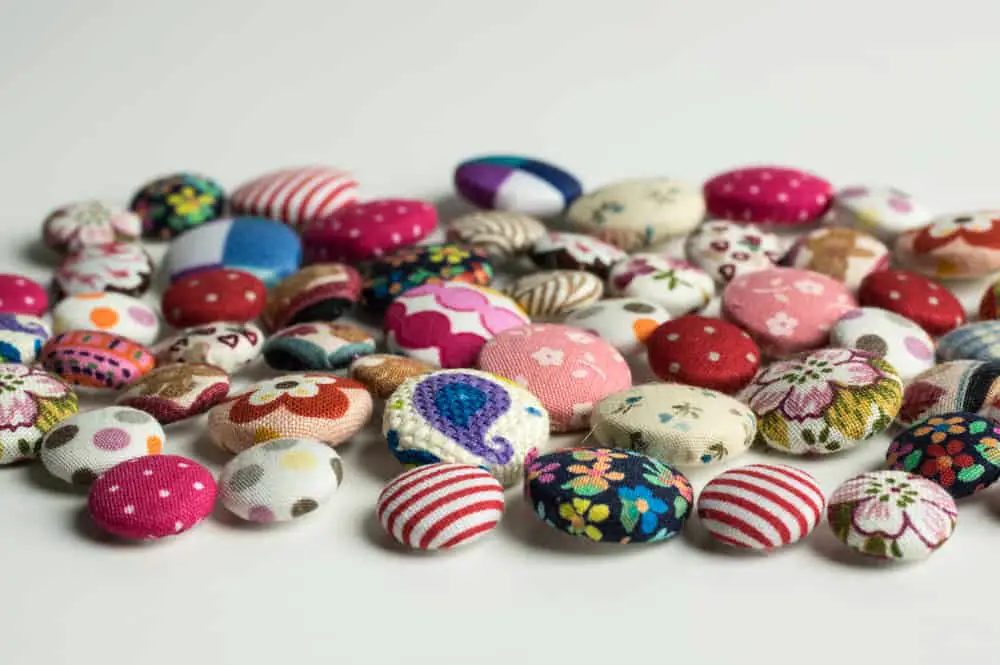
Fabric buttons are very popular as they can be covered in any type of fabric to match that of the coat or to create a striking contrast. While most are mass-produced, you can also find kits to make your own fabric buttons.
Fabric buttons are usually shank buttons covered with a piece of colored fabric, such as silk, linen, or even wool. For a thick winter coat, you will want large fabric buttons, while on a delicate blouse small buttons are preferable, so the fabric won’t sag.
The covering might differ in color from that of the garment, but the fabric needs to be the same to create an aesthetically pleasing effect.
Glass Buttons
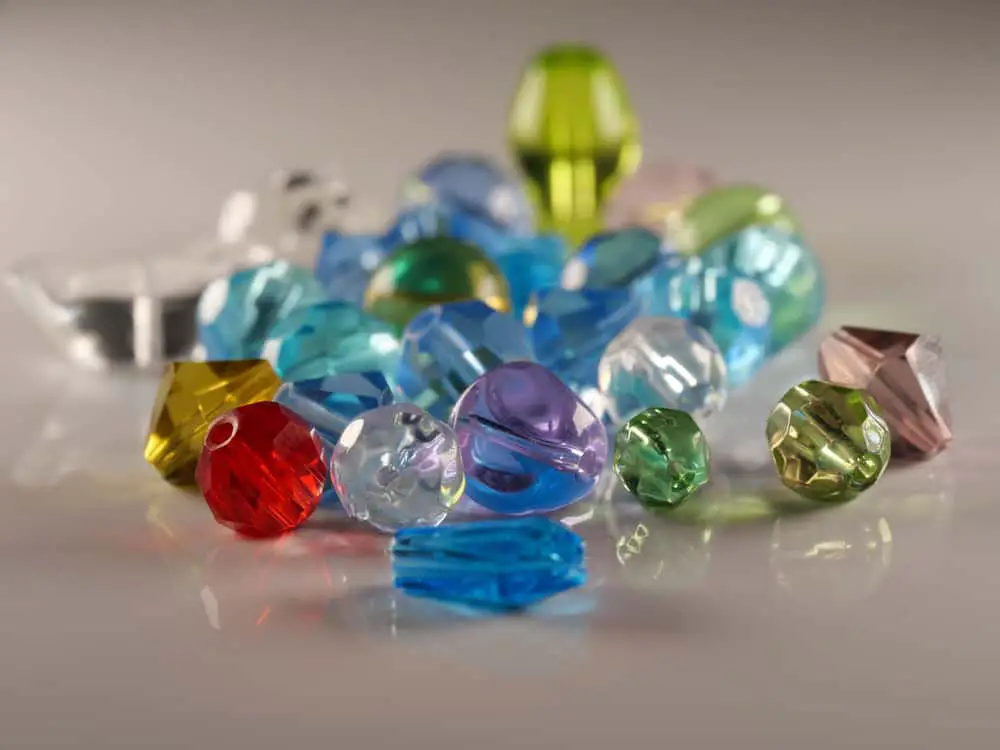
These are the type of buttons you’ll want on a light blouse or dress. Glass buttons can brighten any outfit as they catch and reflect the light creating a spectacular effect. They come in various colors and patterns, matching those of the fabric.
They have a small glass loop underneath and they’re quite easy to sew. Glass is scratch-resistant and you don’t have to worry the colors of the buttons will fade away with time.
Small buttons are preferable as glass is a heavy material and you don’t want them to be dangling from your splendid silk blouse.
Horn Buttons
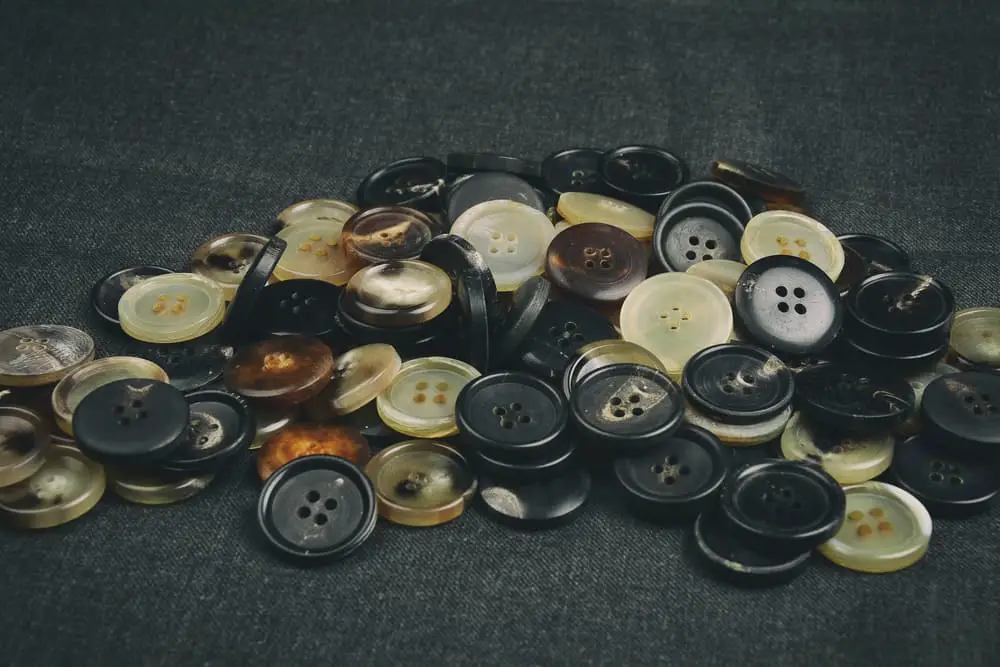
If you buy yourself a thick solid coat guaranteed to last for many years, horn buttons are a perfect choice as they are incredibly resistant, plus they give any item a sophisticated look.
Usually, these buttons are made from the horns of sheep or large animals like water buffaloes, cattle, or deer. Most of the time, such buttons are handmade as it is quite a complex process.
You need to heat the horn to make it softer, then you cut it into smaller pieces and mold the buttons in a metal die. As a result, these buttons are unique as no two pieces even coming from the same horn are exactly the same.
Leather Buttons
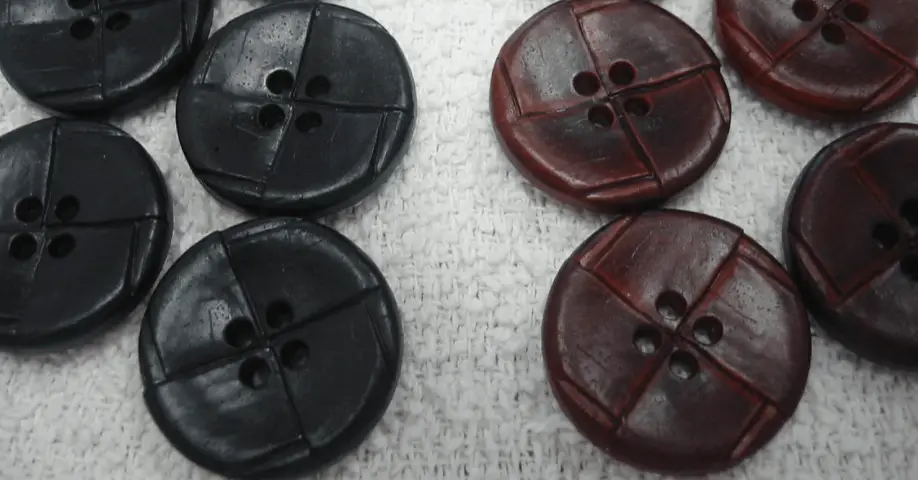
Buttons made of leather go perfectly with a leather jacket as well as on wool and other thick fabric. Leather buttons are usually bigger than regular plastic buttons, which is why they’re more suitable for heavy-duty garments.
Most of the time, leather buttons are in fact shanks covered in real (or fake) leather. When the leather is applied on a round domed shank, the button looks like a miniature football, and, as matter of fact, such buttons are also known as football buttons.
However, you can also find flat leather buttons, which have a very rustic look and go well on knitted garments.
Metal Buttons

Metal is inexpensive and easy to mold, which is why this material is very practical and economical when it comes to buttons. Metal buttons can be made of tin, brass, stainless steel, or even gold or silver.
Metal buttons can be flat with two or four holes, the perfect accessory for a denim shirt, but you can also find exquisite shank buttons bearing a geometric design or a certain brand logo.
Snap buttons and studs are also made of metal since this material is very resistant, therefore well-suited for jeans and jackets.
Mother of Pearl Buttons

While pearls sure make stupendous buttons, they’re way too expensive for such a purpose. Most of the pearl-looking buttons are cheap imitations, although the effect is great. If you want something natural and quite splendid look for mother of pearl buttons.
These are made from the inner layer of some oyster shells, also known as nacre. Mother of pearl buttons stand out for their distinctive shine, and they go well on silky blouses or dresses.
Mother of pearl comes in three main colors, or better said, shades – white, off-white, and pale translucent pink.
Plastic Buttons

Plastic is the most affordable material for buttons, which is why such buttons are the most common. Plastic can be molded into various shapes and it can have every possible color or shade.
Flat plastic buttons are widely used for shirts and blouses, but they can also be applied for a simple decorative purpose, like on the corsage of a light summer dress.
While small buttons are the norm for the basic office shirt, large colorful buttons can be used on a light jacket or a knitted garment to give it a more polished look.
Polyester Buttons
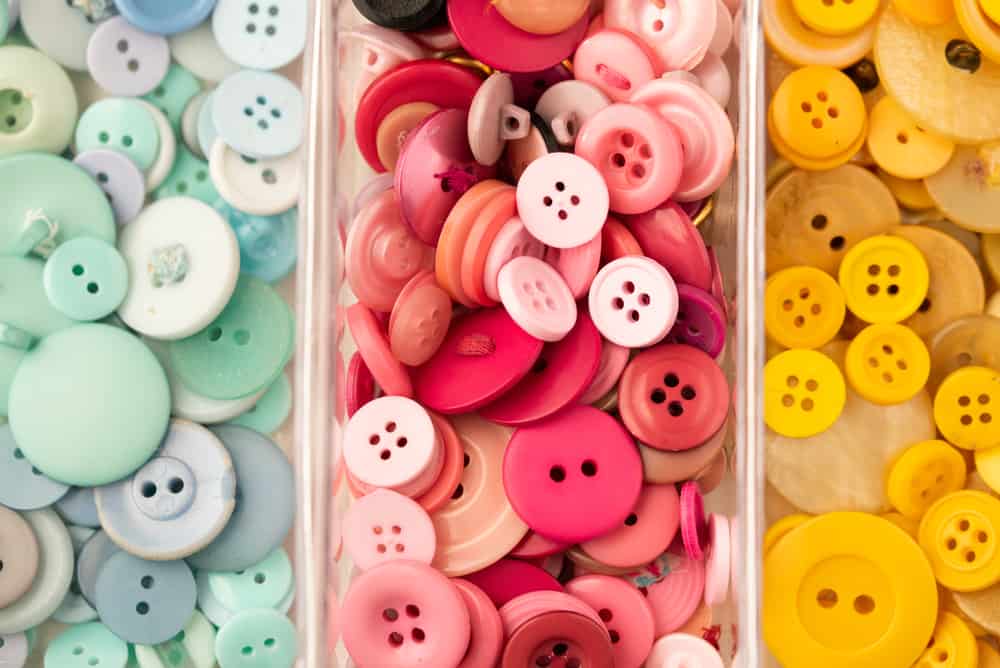
Many people are confused when it comes to polyester and plastic, but they are not the same thing. While some types of polyester can be used to make plastic, polyester is very versatile and can be used to imitate various more expensive materials, such as wood, bone, or even pearl.
This material can be either natural or synthetic and, unless analyzed under a microscope, no one will be able to tell the buttons on your shirt are polyester rather than mother of pearl.
Polyester is easily moldable, so buttons made of it can have practically any shape and shade you want.
Shell Buttons
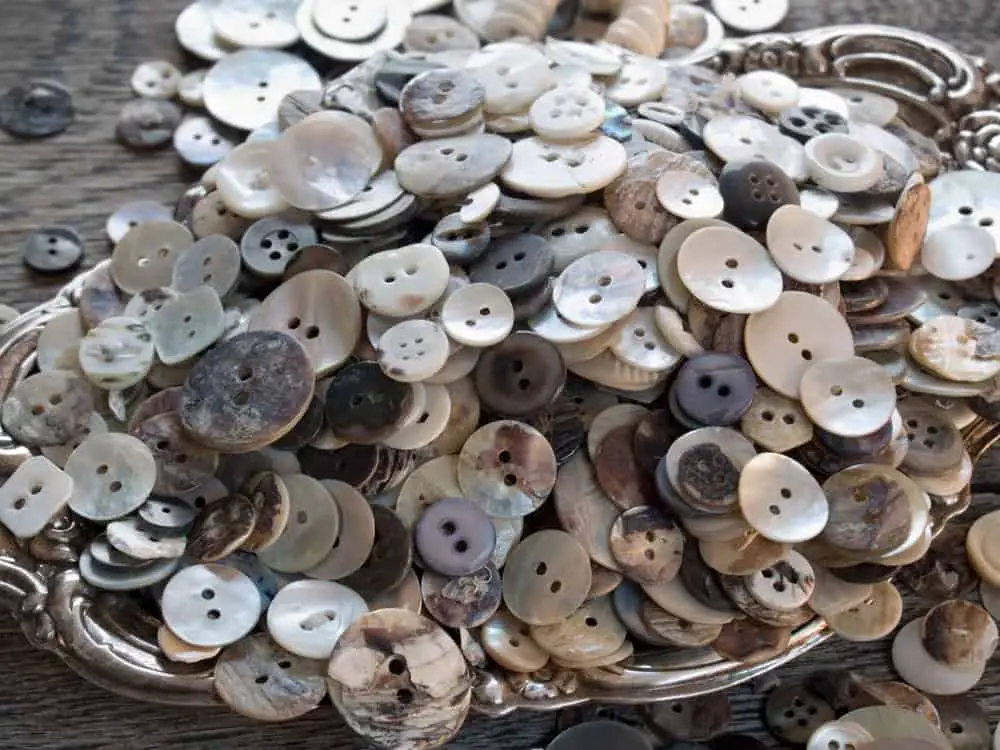
Just as the name indicates, these buttons are made from shells and there’s a great variety out there. The buttons are made from the various layers of big hard shells, but they can also be made from smaller shells.
Typically, the visible part of the button will be shiny and smooth, with the rougher part of the shell hidden on the other side This is an eco-friendly sustainable material which explains why it is increasingly popular today.
Wooden Buttons
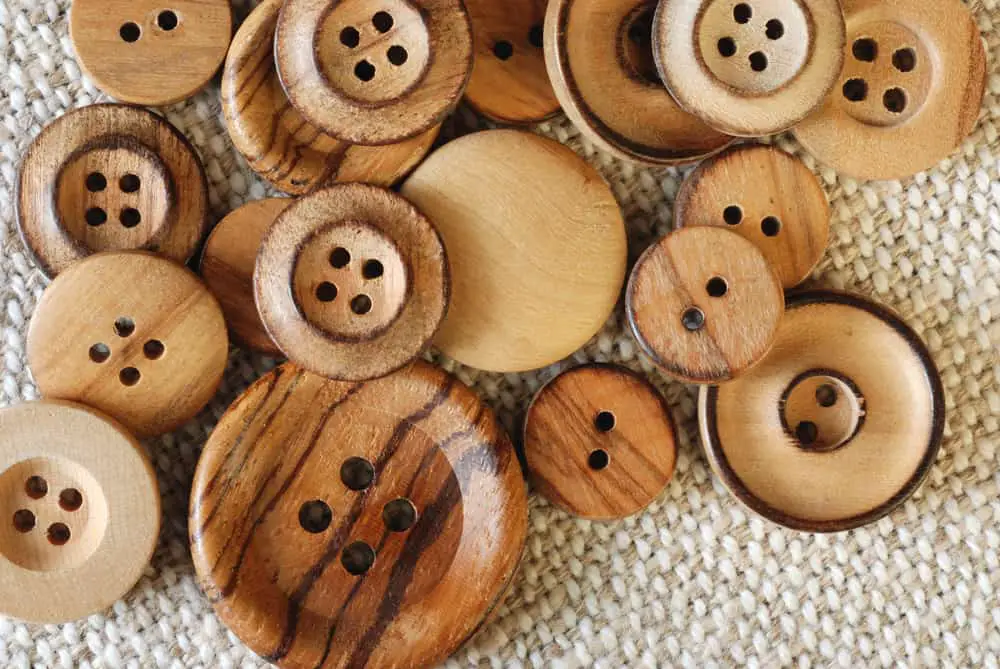
Wooden buttons are very popular since wood is affordable, durable, and easy to work with. Not to mention that wood is way more eco-friendly than the heavily-polluting plastic. Wood can be cut in every shape or size. Flatwood buttons go great on a light linen shirt, while oversized round buttons or toggles are more suited for thick coats and knitted garments.
Frequently Asked Questions about Buttons:
When Were Buttons First Used on Clothing?
The oldest button in the world is some 5,000 years old. It’s a rounded shell button found at the Mohenjo Daro site in the Indus valley. In Ancient times, buttons had mostly a decorative value.
It was the Romans that first devised a truly functional button that went through a loop to keep the ample folds of their togas in place.
What Are Wedding Dress Buttons Called?
A wedding dress with a long train must have a few discreet and well-hidden buttons on the back of the skirt. These buttons are often referred to as bustle, as such is their role.
After the ceremony is over and the pictures taken, the bridesmaids will gather up or bustle the train of the dress, using the buttons to keep the swaths of fabric in place. And the bride is now free to move and have some fun at her wedding!
How Do You Put a Button on Fabric?
Most buttons are sewn on the fabric. This is the case with flat two-hole or four-hole buttons, as well as for shank buttons.
However, snap and stud buttons are affixed to the fabric with special machines that use pressure to fit the metallic parts of these types of buttons together.
How Do You Tighten Pants with Buttons?
If for some reason your pants are way too loose to feel comfortable, you can tighten them instantly using a simple trick.
Just grab hold of the belt loop that is closest to the button and loop it once around the said button.
All you have to do now is button those pants, as usual, making sure the belt loop stays in place.
Preferably, wear a large sweater or a coat over the corduroy pants so the trick and the slightly bulging fabric won’t be noticeable.
How Do You Sew a Button on Fabric?
That depends on the type of button. Flat two-hole buttons are the easiest to sew. Just grab a needle and some thread (in a color that matches the fabric or the button). Place the button on the desired spot and push the needle through one hole from underneath.
Next, you put the needle through the other hole to get back underneath. Repeat this several times, until the button seems secured in place. When you’re done, don’t forget to make a knot underneath, before cutting the thread.
Four-whole buttons can be sewn pretty much the same way. Since you have four holes you will have two lines, which can be either parallel or crisscrossed.
